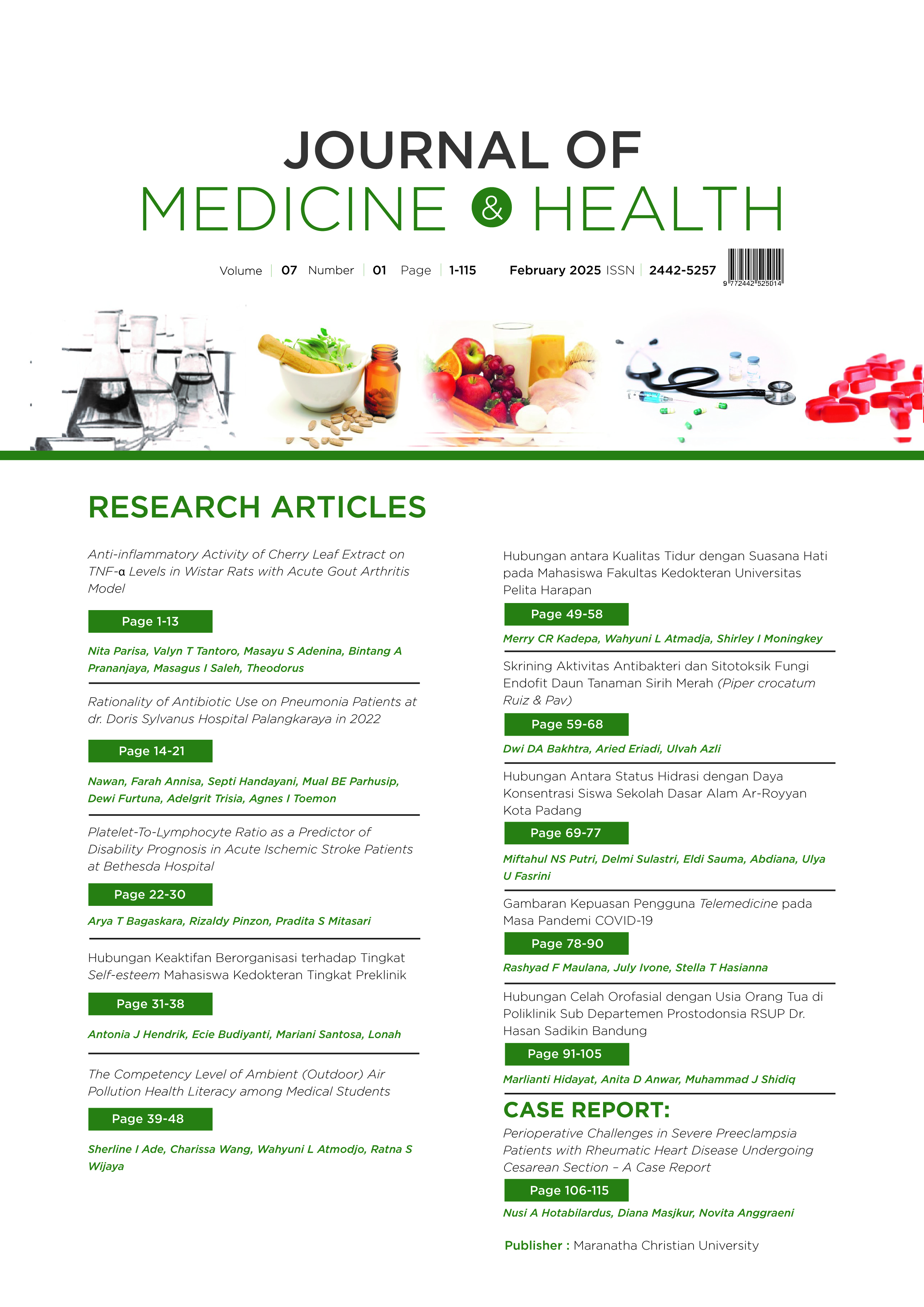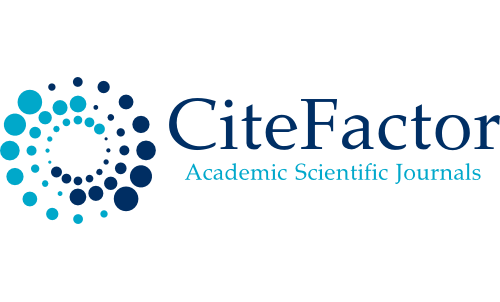Platelet-To-Lymphocyte Ratio as a Predictor of Disability Prognosis in Acute Ischemic Stroke Patients at Bethesda Hospital
DOI:
https://doi.org/10.28932/jmh.v7i1.9809Keywords:
acute ischemic stroke, platelet-to-lymphocyte ratio, stroke patients, stroke disabilityAbstract
Stroke precipitates a neuroinflammatory response. Platelet-to-lymphocyte ratio (PLR) is an inflammatory biomarker conveying plaque adhesion and infarct volume. A high level of PLR is associated with stroke patient’s poor clinical outcomes. This study highlights PLR's potential as a predictive biomarker for post-stroke disability. This study aims to measure PLR at admission and to investigate its potential as a predictor for post-stroke disability. A retrospective cohort study was designed with 98 subjects from Bethesda Hospital Yogyakarta. ROC/AUC analyzed PLR to find the optimal cut-off value. Risk factors were analyzed to find the correlation and causality. From 98 patients, the optimal PLR cut-off is 146.86. A significant positive correlation was observed between PLR and modified Rankin Scale (mRS) scores (p=0.017), and National Institutes of Health Stroke Scale (NIHSS) scores (p=0.043). A significant mean difference in PLR values was also identified between mRS outcomes (p=0.017). PLR was a predictor for mRS (OR=4.051, p=0.037), although it did not predict NIHSS outcomes. The findings indicate that PLR is predictive of post-stroke disability in cases of ischemic stroke. An elevation in PLR suggests a disequilibrium between inflammatory mediators and neuroprotective factors. In conclusion, PLR has the potential as a predictor for post-stroke disability in ischemic strokeDownloads
References
Turana Y, Tengkawan J, Chia YC, Nathaniel M, Wang JG, Sukonthasarn A, et al. Hypertension and stroke in Asia: A comprehensive review from HOPE Asia. John Wiley and Sons Inc; J Clin Hyper. 2021; 23:513–21.
Feigin VL, Stark BA, Johnson CO, Roth GA, Bisignano C, Abady GG, et al. Global, regional, and national burden of stroke and its risk factors, 1990–2019: a systematic analysis for the Global Burden of Disease Study 2019. Lancet Neurol; 2021; 20(10):795-820
Feigin VL, Brainin M, Norrving B, Martins S, Sacco RL, Hacke W, et al. World Stroke Organization (WSO): Global Stroke Fact Sheet 2022. SAGE Publications Inc. Int J Stroke. 2022;17(1):18–29.
Setyopranoto I, Bayuangga HF, Panggabean AS, Alifaningdyah S, Lazuardi L, Dewi FST, et al. Prevalence of stroke and associated risk factors in Sleman district of Yogyakarta Special Region, Indonesia. Stroke Res Treat. 2019;2019(1):2642458
Venketasubramanian N, Yudiarto FL, Tugasworo D. Stroke Burden and Stroke Services in Indonesia. Cerebrovasc Dis Extra. 2022;12(1):53–7.
Yao YY, Wei ZJ, Zhang YC, Li X, Gong L, Zhou JW, et al. Functional Disability After Ischemic Stroke: A Community-Based Cross-Sectional Study in Shanghai, China. Front Neurol. 2021;12:: 1–8
Ju YW, Lee JS, Choi YA, Kim YH. Causes and Trends of Disabilities in Community-Dwelling Stroke Survivors: A Population-Based Study. Brain & Neurorehabilitation. 2022;15(1):e5
Lv Y, Sun Q, Li J, Zhang W, He Y, Zhou Y. Disability status and its influencing factors among stroke patients in northeast china: A 3-year follow-up study. Neuropsychiatr Dis Treat. 2021(17):2567–73.
Sharma D, Bhaskar SMM. Prognostic Role of the Platelet-Lymphocyte Ratio in Acute Ischemic Stroke Patients Undergoing Reperfusion Therapy: A Meta-Analysis. J Cent Nerv Syst Dis. 2022;(14):1–16.
Yan YK, Huang H, Li DP, Ai ZY, Li X, Sun Z. Prognostic value of the platelet-to-lymphocyte ratio for outcomes of stroke: A systematic review and meta-analysis. European Revi Med Pharmacol Sci. 2021;25(21): 6259-538
Sun YY, Wang MQ, Wang Y, Sun X, Qu Y, Zhu HJ, et al. The platelet-to-lymphocyte ratio at 24h after thrombolysis is a prognostic marker in acute ischemic stroke patients. Front Immunol. 2022;26(13):1166275-9
Ma J, Guo W, Xu J, Li S, Ren C, Wu L, et al. Association of platelet-to-lymphocyte ratio and neutrophil-to-lymphocyte ratio with outcomes in stroke patients achieving successful recanalization by endovascular thrombectomy. Front Neurol. 2022;13:1039060
Hu J, Wang L, Fan K, Ren W, Wang Q, Ruan Y, et al. The association between systemic inflammatory markers and post-stroke depression: A prospective stroke cohort. Clin Interv Aging. 2021;16:1231–9.
Li LH, Chen CT, Chang YC, Chen YJ, Lee IH, How CK. Prognostic role of neutrophil-to-lymphocyte ratio, platelet-to-lymphocyte ratio, and systemic immune inflammation index in acute ischemic stroke: A STROBE-compliant retrospective study. Med (United States). 2021;100(25):E26354.
Juli C, Heryaman H, Nazir A, Ang ET, Defi IR, Gamayani U, et al. The lymphocyte depletion in patients with acute ischemic stroke associated with poor neurologic outcome. Int J Gen Med. 2021;14:1843–51.
Candelario-Jalil E, Dijkhuizen RM, Magnus T. Neuroinflammation, Stroke, Blood-Brain Barrier Dysfunction, and Imaging Modalities. Stroke. 2022;53(5):1473–86.
Gong P, Liu Y, Gong Y, Chen G, Zhang X, Wang S, et al. The association of neutrophil to lymphocyte ratio, platelet to lymphocyte ratio, and lymphocyte to monocyte ratio with post-thrombolysis early neurological outcomes in patients with acute ischemic stroke. J Neuroinflammation. 2021;18(51):1–11.
Xu JH, He XW, Li Q, Liu JR, Zhuang MT, Huang FF, et al. Higher Platelet-to-Lymphocyte Ratio Is Associated With Worse Outcomes After Intravenous Thrombolysis in Acute Ischemic Stroke. Front Neurol. 2019;10:1–8.
Zhang YX, Shen ZY, Jia YC, Guo X, Guo XS, Xing Y, et al. The Association of the Neutrophil-to-Lymphocyte Ratio, Platelet-to-Lymphocyte Ratio, Lymphocyte-to-Monocyte Ratio, and Systemic Inflammation Response Index with Short-Term Functional Outcome in Patients with Acute Ischemic Stroke. J Inflamm Res. 2023;16:3619–30.
Komurcu HF, Gozke E, Dogan Ak P, Kalyoncu Aslan I, Salt I, Ozgenc Bi er CI. Changes in neutrophil, lymphocyte, platelet ratios and their relationship with NIHSS after rtPA and/or thrombectomy in ischemic stroke. J Stroke Cerebrovasc Dis. 2020;29(8):105004
Simats A, Liesz A. Systemic inflammation after stroke: implications for post-stroke comorbidities. EMBO Mol Med. 2022;14(9):1-18.
Tudor R, Iovanescu G, Reisz D, Cornea A, Potre-Oncu C, Tutelca A, et al. Additional factors to corelate with a more than 30% NIHSS score improvement in patients 7 days after fibrinolytic and/or endovascular treatment for ischemic stroke. BMC Neurol. 2020;20(1):1–7.
Gupta I, Mathur M, Sonkar K, Gupta P, ChaurasiaCollege MLNM: Original Research Paper Neurology Predicting Poor Neurological Outcome In Acute Hemorrhagic Stroke As Compared To Acute Ischemic Stroke – A Prospective. 2023;12(1):64–6.
Downloads
Published
How to Cite
Issue
Section
License
Copyright (c) 2025 Arya T Bagaskara, Rizaldy Pinzon, Pradita S Mitasari

This work is licensed under a Creative Commons Attribution-NonCommercial 4.0 International License.
Authors who publish with this journal agree to the following terms:
- Authors retain the copyright and grant the journal right of first publication with the work
simultaneously licensed under a Creative Commons Attribution-NonCommercial 4.0 International License that allows others to share the work with an acknowledgement of the work's authorship and initial publication in this journal. - Authors are able to enter into separate, additional contractual arrangements for the nonexclusive distribution of the journal's published version of the work (e.g., post it to an institutional repository or publish it in a book), with an acknowledgement of its initial publication in this journal.
 This work is licensed under a Creative Commons Attribution-NonCommercial 4.0 International License.
This work is licensed under a Creative Commons Attribution-NonCommercial 4.0 International License.

















